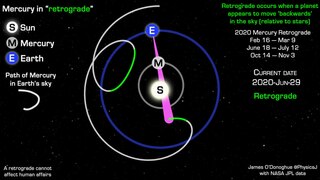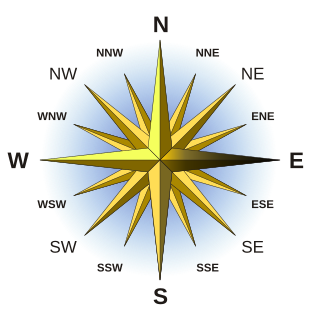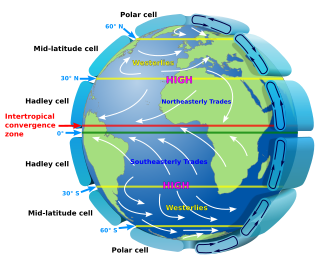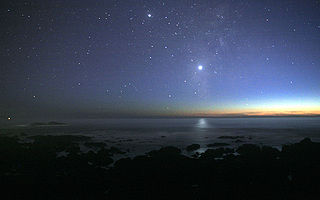This article needs additional citations for verification .(August 2019) |

West is one of the four cardinal directions or points of the compass. It is the opposite direction from east and is the direction in which the Sun sets on the Earth.
This article needs additional citations for verification .(August 2019) |

West is one of the four cardinal directions or points of the compass. It is the opposite direction from east and is the direction in which the Sun sets on the Earth.
The word "west" is a Germanic word passed into some Romance languages (ouest in French, oest in Catalan, ovest in Italian, oeste in Spanish and Portuguese). As in other languages, the word formation stems from the fact that west is the direction of the setting sun in the evening: 'west' derives from the Indo-European root *wes reduced from *wes-pero 'evening, night', cognate with Ancient Greek ἕσπερος hesperos 'evening; evening star; western' and Latin vesper 'evening; west'. [1] Examples of the same formation in other languages include Latin occidens 'west' from occidō 'to go down, to set' and Hebrew מַעֲרָב maarav 'west' from עֶרֶב round 'evening'.
West is sometimes abbreviated as W.
To go west using a compass for navigation (in a place where magnetic north is the same direction as true north) one needs to set a bearing or azimuth of 270°.
West is the direction opposite that of the Earth's rotation on its axis, and is therefore the general direction towards which the Sun appears to constantly progress and eventually set. This is not true on the planet Venus, which rotates in the opposite direction from the Earth (retrograde rotation). To an observer on the surface of Venus, the Sun would rise in the west and set in the east [2] although Venus's opaque clouds prevent observing the Sun from the planet's surface. [3]
In a map with north at the top, west is on the left.
Moving continuously west is following a circle of latitude.
Due to the direction of the Earth's rotation, the prevailing wind in many places in the middle latitudes (i.e. between 35 and 65 degrees latitude) is from the west, known as the westerlies. [4] [5]
The phrase "the West" is often spoken in reference to the Western world, which includes the European Union (also the EFTA countries), the United Kingdom, the Americas, Israel, Australia, New Zealand and (in part) South Africa.
The concept of the Western part of the earth has its roots in the Western Roman Empire and the Western Christianity. During the Cold War "the West" was often used to refer to the NATO camp as opposed to the Warsaw Pact and non-aligned nations. The expression survives, with an increasingly ambiguous meaning.
In Chinese Buddhism, the West represents movement toward the Buddha or enlightenment (see Journey to the West). The ancient Aztecs believed that the West was the realm of the great goddess of water, mist, and maize. In Ancient Egypt, the West was considered to be the portal to the netherworld, and is the cardinal direction regarded in connection with death, though not always with a negative connotation. Ancient Egyptians also believed that the Goddess Amunet was a personification of the West. [6] The Celts believed that beyond the western sea off the edges of all maps lay the Otherworld, or Afterlife.
In Judaism, west is seen to be toward the Shekinah (presence) of God, as in Jewish history the Tabernacle and subsequent Jerusalem Temple faced east, with God's Presence in the Holy of Holies up the steps to the west. According to the Bible, the Israelites crossed the Jordan River westward into the Promised Land. In Islam, while in India, people pray facing towards the west as in respect to Mecca, Mecca is in the West-ward direction.
In American literature (e.g., in The Great Gatsby ) moving West has sometimes symbolized gaining freedom, perhaps as an association with the settling of the Wild West (see also the American frontier and Manifest Destiny).
A solar equinox is a moment in time when the Sun crosses the Earth's equator, which is to say, appears directly above the equator, rather than north or south of the equator. On the day of the equinox, the Sun appears to rise "due east" and set "due west". This occurs twice each year, around 20 March and 23 September.

Venus is the second planet from the Sun. It has the densest atmosphere of all rocky bodies in the Solar System, so dense that at surface level and 92 atmospheres, it is a supercritical fluid. The planet's surface is dominated by volcanoes – there are 167 Venusian volcanoes that are over 100 km (60 mi) across. Venus has a diameter roughly equal to Earth's at 12,104 km (7,521 mi) and is classified as a terrestrial planet.

Apparent retrograde motion is the apparent motion of a planet in a direction opposite to that of other bodies within its system, as observed from a particular vantage point. Direct motion or prograde motion is motion in the same direction as other bodies.

The zenith is an imaginary point directly "above" a particular location, on the celestial sphere. "Above" means in the vertical direction opposite to the gravity direction at that location (nadir). The zenith is the "highest" point on the celestial sphere.

A prime meridian is an arbitrarily-chosen meridian in a geographic coordinate system at which longitude is defined to be 0°. Together, a prime meridian and its anti-meridian form a great circle. This great circle divides a spheroid, like Earth, into two hemispheres: the Eastern Hemisphere and the Western Hemisphere. For Earth's prime meridian, various conventions have been used or advocated in different regions throughout history. Earth's current international standard prime meridian is the IERS Reference Meridian. It is derived, but differs slightly, from the Greenwich Meridian, the previous standard.

North is one of the four compass points or cardinal directions. It is the opposite of south and is perpendicular to east and west. North is a noun, adjective, or adverb indicating direction or geography.

East is one of the four cardinal directions or points of the compass. It is the opposite direction from west and is the direction from which the Sun rises on the Earth.

In astronomy, an analemma is a diagram showing the position of the Sun in the sky as seen from a fixed location on Earth at the same mean solar time, as that position varies over the course of a year. The diagram will resemble a figure eight. Globes of Earth often display an analemma as a two-dimensional figure of equation of time vs. declination of the Sun.

Sunset is the disappearance of the Sun below the horizon of the Earth due to its rotation. As viewed from everywhere on Earth, it is a phenomenon that happens approximately once every 24 hours, except in areas close to the poles. The equinox Sun sets due west at the moment of both the spring and autumn equinoxes. As viewed from the Northern Hemisphere, the Sun sets to the northwest in the spring and summer, and to the southwest in the autumn and winter; these seasons are reversed for the Southern Hemisphere.

The four cardinal directions, or cardinal points, are the four main compass directions: north, south, east, and west, commonly denoted by their initials N, S, E, and W respectively. Relative to north, the directions east, south, and west are at 90 degree intervals in the clockwise direction.

Night is the period of ambient darkness from sunset to sunrise during each 24-hour day, when the Sun is below the horizon. The exact time when night begins and ends depends on the location and varies throughout the year, based on factors such as season and latitude.

Atmospheric circulation is the large-scale movement of air and together with ocean circulation is the means by which thermal energy is redistributed on the surface of the Earth. The Earth's atmospheric circulation varies from year to year, but the large-scale structure of its circulation remains fairly constant. The smaller-scale weather systems – mid-latitude depressions, or tropical convective cells – occur chaotically, and long-range weather predictions of those cannot be made beyond ten days in practice, or a month in theory.

A high-pressure area, high, or anticyclone, is an area near the surface of a planet where the atmospheric pressure is greater than the pressure in the surrounding regions. Highs are middle-scale meteorological features that result from interplays between the relatively larger-scale dynamics of an entire planet's atmospheric circulation.

In meteorology, prevailing wind in a region of the Earth's surface is a surface wind that blows predominantly from a particular direction. The dominant winds are the trends in direction of wind with the highest speed over a particular point on the Earth's surface at any given time. A region's prevailing and dominant winds are the result of global patterns of movement in the Earth's atmosphere. In general, winds are predominantly easterly at low latitudes globally. In the mid-latitudes, westerly winds are dominant, and their strength is largely determined by the polar cyclone. In areas where winds tend to be light, the sea breeze/land breeze cycle is the most important cause of the prevailing wind; in areas which have variable terrain, mountain and valley breezes dominate the wind pattern. Highly elevated surfaces can induce a thermal low, which then augments the environmental wind flow.

The westerlies, anti-trades, or prevailing westerlies, are prevailing winds from the west toward the east in the middle latitudes between 30 and 60 degrees latitude. They originate from the high-pressure areas in the horse latitudes and trend towards the poles and steer extratropical cyclones in this general manner. Tropical cyclones which cross the subtropical ridge axis into the westerlies recurve due to the increased westerly flow. The winds are predominantly from the southwest in the Northern Hemisphere and from the northwest in the Southern Hemisphere.
The Space Trilogy is a series of science fiction novels by C. S. Lewis. The trilogy consists of Out of the Silent Planet (1938), Perelandra (1943), and That Hideous Strength (1945). A philologist named Elwin Ransom is the protagonist of the first two novels and an important character in the third.

Observations of the planet Venus include those in antiquity, telescopic observations, and from visiting spacecraft. Spacecraft have performed various flybys, orbits, and landings on Venus, including balloon probes that floated in the atmosphere of Venus. Study of the planet is aided by its relatively close proximity to the Earth, compared to other planets, but the surface of Venus is obscured by an atmosphere opaque to visible light.

Retrograde motion in astronomy is, in general, orbital or rotational motion of an object in the direction opposite the rotation of its primary, that is, the central object. It may also describe other motions such as precession or nutation of an object's rotational axis. Prograde or direct motion is more normal motion in the same direction as the primary rotates. However, "retrograde" and "prograde" can also refer to an object other than the primary if so described. The direction of rotation is determined by an inertial frame of reference, such as distant fixed stars.

Venus, as one of the brightest objects in the sky, has been known since prehistoric times and has been a major fixture in human culture for as long as records have existed. As such, it has a prominent position in human culture, religion, and myth. It has been made sacred to gods of many cultures, and has been a prime inspiration for writers and poets as the morning star and evening star.

Burt's solar compass or astronomical compass/sun compass is a surveying instrument that makes use of the Sun's direction instead of magnetism. William Austin Burt invented his solar compass in 1835. The solar compass works on the principle that the direction to the Sun at a specified time can be calculated if the position of the observer on the surface of the Earth is known, to a similar precision. The direction can be described in terms of the angle of the Sun relative to the axis of rotation of the planet.